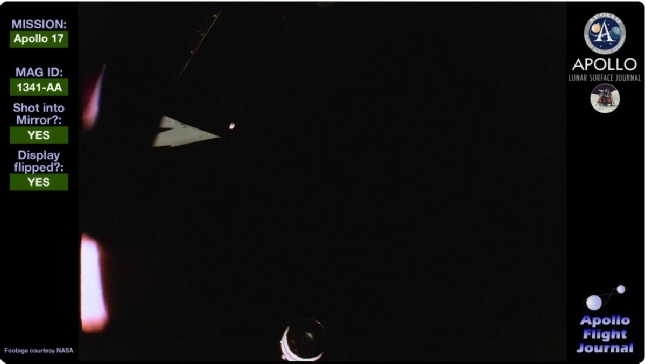5.11: Remote probes took the photographs
This seems to be the argument the hoax community have decided on. It gets them out of a hole nicely. With the claims of the main fraudsters and charlatans completely discredited by this research (it clearly isn’t a transparency overlaid on a window, neither was it filmed in LEO), this is the only recourse for them.
Is it reasonable?
Well, evidently there is the capability to transmit TV images over long distances, and evidently those TV images can be in colour. There is also the capability to control unmanned vehicles remotely. What the conspiracy lovers can not do, however, is identify which unmanned probe took the live TV images, or state when this probe was launched, or who was controlling it, or why the voices of Armstrong, Collins and Aldrin are tracked as coming from the moon (with the correct delay for the distance) and not from either Earth (which would give an incorrect voice delay) or from LEO (which would be instantly detectable because of the orbital speed this would require).
We can at least look at the kind of capabilities unmanned probes had, and for that we have evidence from lunar orbit, namely the Lunar Orbiter series ones that were used to provide mapping and other supporting data for the Apollo landings.
Figure 5.11.1a shows Lunar Orbiter 1’s first image of Earth from lunar orbit as printed in numerous magazines at the time. The LOIRP have produced a much cleaned up version (see the articles on this page), but it should be pretty obvious that the view of Earth is not the quality we have seen in Apollo photographs, and neither is it in colour. Figure 5.11.1b shows that cleaned up version in comparison with a NIMBUS image from the date it was taken, August 23rd 1966.

Figure 5.11.1a: First ever Earthrise photograph, taken by Lunar Orbiter I on 23/08/66. Source.
Figure 5.11.1c: Lunar Orbiter Earthrise in a Dutch newspaper. The text suggests it’s what they saw. Source.
Lunar Orbiter V returned a much better photograph on 08/08/67, available here and shown in figure 5.11.2 below, along with ESSA satellite data. The ESSA image date is August 7th, but for reasons outlined in great detail elsewhere in this research by the time it covers this area in the Lunar Orbiter image it is the 8th.
This image is very good quality, and we have to concede that there is an impressive amount of detail. It is, however, still in black & white, not colour, and the unfortunate thing for the conspiracy theorist is that all of the Lunar Orbiters were crashed into the moon long before the first Apollo went anywhere near there.
The probes also did a lot of research into things like radiation, micro-
One moon hoax proponent has tried to use the Lunar Orbiter 1 image to claim that Apollo photos are faked, His claim looks like this (figure 5.11.3)
Surveyor’s images were sent back as TV signals, and the lines in this image are obvious. It is also nothing like as clear as most of the lunar based Apollo views of Earth. It’s also not true colour as such: as with the ATS colour satellite views red, green and blue filters were used that could be combined later.
Fans of Apollo 12 will remember that the piece of equipment that broadcast this image was retrieved by the Apollo 12 astronauts from the surface of the moon.
A later probe, Surveyor 7, did produce some much better quality pictures of Earth.
The images can be found in this document, which summarises the results from all the Surveyor probes. Interestingly, Surveyor VII also took pictures of laser beams fired from Kitt’s Peak observatory, something that was also tried during Apollo 11 and that also acted as proof that the planned laser reflector experiments deployed during Apollo would work. Figure 5.11.6 shows the images of Earth taken by the probe, along with an original negative discussed on this page.

Figure 5.11.7: Stacked image of Earth taken by Surveyor 7 in comparison with satellite imagery (left) and 3D reconstruction using digitally restored ESSA data (right).
They are undeniably of good quality. They are also undeniably in black and white and from a probe that stopped sending images long before Apollo 8 got anywhere near the moon, and the projection does make identification difficult in places -
The discarded S-
We can employ exactly the same criticism to Rasa Viharii, who claims to work for China’s Space Agency (yeah right, they let Americans do that), who proposes that all the photos of Earth were taken by unmanned probes with a camera mounted on the outside, because apparently no handheld camera existed capable of that level of detail. Outside. In a vacuum. Remember the problems he thinks that would cause the film?
He doesn’t identify which colour camera was involved, nor does he seem to be aware (or is ignoring) the many shots which are very obviously taken from inside Apollo spacecraft or on the lunar surface, nor the ones where Earth is duplicated in the doubled glazed Apollo windows, or the blurred and out of focus ones, or where the viewing angle changes because the photographer has moved, or where the same view has been taken on two different magazines but the same camera, or the ones taken by live TV or by 16mm cameras. Figure 5.11.8 shows just a few examples of the many available.
Figure 5.11.6: Surveyor VII views of Earth taken 22-
Just for fun, here’s a close up in figure 5.11.7 of a re-






Figure 5.11.2: Lunar Orbiter V image of Earth compared with ESSA data and 3D reconstruction using digitally restored ESSA data. This image from here, original image here.




So, does this claim have any validity?
No.
These are photographs of the probe and its camera (figure 5.11.4)


Firstly, it did not have many layers of radiation protection, it had a thin layer of aluminium designed to protect against solar flares (see here). Any more protection would have compromised the weight limits. In any case, the shielding was there to protect the probe from long periods of exposure, not short missions. The protection given to it was actually less than that of Apollo, but was still considered more than adequate to deal with the Van Allen belts.
Radiation detectors on the probes allowed them to modify the processing regime in the event of high radiation levels. In fact, as this document states, one of the main protections from radiation afforded the camera (in the event of a high solar particle event) was to physically change the orientation of the probe so that more of it was between the sun and the camera! The Geiger counters, shielded by the same level of aluminium as the cameras and film, would detect high levels and:
“..it would be possible for the mission control to minimize the darkening of the film by operational maneuvers, such as stopping the photographic operation and acceleration of development of the film in the loopers, and in case of more penetrating events, shielding the film in the cassette by the spacecraft itself and by the moon.”
Furthermore, the doses that these counters actually measured indicated that the shielding provided by crew cabins and suits would be more than adequate unless the event was extreme.
“The radiation experiments produced data which confirmed that the design of the hardware that Apollo astronauts would use on their lunar missions beginning in 1969 would protect them from average and greater than average short-
Secondly, the pressure vessel was nitrogen at at 1-
This comprehensive document on the orbiter’s design and function has this to say about pressure:
"2.2.9.3 Pressure. The environmental gas in the [photographic subsystem] pressure shell is made up of 99 percent nitrogen and a total of I percent oxygen and other gases. Oxygen must be below 1 percent by volume to prevent loss of potency in the Bimat. Prior to launch, the nitrogen in the pressure shell is maintained at 1.9 psi above atmospheric pressure to prevent air leakage into the shell. This pressure differential is maintained throughout the launch phase by a relief valve which operates as the external pressure decreases.
During the photographic mission, pressure within the shell is maintained above 1.0 psia by nitrogen supplied from a pressurized bottle. This supply will allow for leakage equivalent to three pressure shell volumes of 1.0 psia at 70F. The lover pressure limit of 1.0 psia is required to keep the boiling point temperature of water above the expected temperatures of materials requiring moisture such as the Bimat film and the humidity control pads."
And this about radiation:
"It is expected that the amounts of radiation received from the Van Allen belts and from the galactlc-
The manufacturers were in no doubt that vacuum and film related issues were not a problem for the probe’s film.
The Apollo cameras were shielding for the film in themselves -
What about photographs from the lunar surface? Were there any taken there? Well, yes there were, by the Surveyor probes, probes that also looked at surface temperature and radiation levels.
Surveyor 1 provided the first colour photographs of the lunar surface, but the first colour photograph of Earth from the surface (taken 30/04/67) came from Surveyor 3, which can be seen in figure 5.11.5. The photograph could only be taken because of a favourable libration (the moon’s “wobble” caused by its interaction with our gravity), and Earth was not usually visible. The image was taken on 30/04/67 at 10:30 GMT. While the Atlantic is largely over-






Figure 5.11.8: Sections of Apollo images showing reflections in windows and obvious internal details. Top to bottom, left to right: AS13-

Figure 5.11.3: Social media claims about lunar orbiter
Figure 5.11.5: Surveyor 3 TV image of Earth compared with 3D reconstruction using restored ESSA data. Source.
He even produces his original tracking notes. Bill Keel’s excellent site describes the various visual tracking activities from observatories and by amateurs.
These radio hams knew what they were doing. They would not be fooled by an object supposedly in LEO that no-
The professional tracking stations were also not likely to be fooled. Their large dishes were pointed specifically at the moon and received transmission for hours at a time. Even those not involved in the missions directly could track them, such as the big dish at Jodrell bank, or Parkes, amongst many others not directly involved in the missions (see, for example, the ones listed here). This article describes how an Italian radio telescope was used to record data and voice transmissions on NASA’s behalf as a back up. The reporter contacted those involved, stating that:
“They guaranteed me that what they were listening to came from the Moon, because with that radio telescope you could only listen to communications that came from the Moon and not something sent from the United States".
This Dutch amateur recorded Apollo 17 conversations, having been inspired by the QST article, having received detailed information from NASA to help:
“On 11 Dec at 0630, Jan clearly heard a signal from the command module (CSM) orbiting the Moon at a strength of 10 dB above the noise. After 10 minutes, the signal was gone due to shadowing on the Moon's surface. The signal returned after an appropriate time. After the astronauts landed on the surface of the Moon, they placed a beacon operating in the 13 cm band on its surface. Jan then used this beacon for a long time for accurate alignment of the dish’s aiming. Jan was the only amateur to listen to Apollo signals from EU. He recorded the astronauts' conversations with the control center.”
The key bit there is the use of a specific piece of equipment set up during the mission! This page shows some of the documentation he received from NASA, and also newspaper articles published at the time.
This page has an bulletin board message discussing the the work:
“I know of at least one Dutch radio amateur, Jan Ottens PA0SSB who used his [Earth Moon Earth] dish (one of the first in PA land to do EME back in those days) to receive the ALSEP packages. He still keeps audio tapes of these which I listened to a while ago... quite a thrill. He also used the dish to listen to the command module S-
A follow up message by another user confirms the details:
“I can confirm that Jan PA0SSB received the ALSEP packages…using the homebrewed 6 meters dish”
Another contributor who worked at Goldstone during the missions records how
“My boss set up a ten foot comm dish in his front yard and using a diode mixer with a signal generator as LO, detected the 2-
Again, note that these contributors are not just talking about equipment in orbit, which people like Jarrah White are claiming can be done with unmanned craft, it’s talking about the signals specifically from the lunar surface, set up during the mission in processes broadcast on live TV, where those TV signals showed verifiable details of Earth. July 1972’s QST also reports ALSEP signal recording, and is discussed in detail here. Also note the use of S-
On top of that, you have the professional and amateur observatories tracking Apollo as part of the Optical Observation Network, aimed at supplementing the Manned Spaceflight network. One of them, Chabot observatory, was crucial in helping the stricken Apollo 13 craft compute it’s re-
You can even include the citizen scientists involved in Operation Moonwatch (figure 5.11.13), where individuals around the world tracked satellites to confirm their orbits, and even spotted Apollo spacecraft. This article describes how Moonwatch tracked Apollo 7, and its participants even contributed to military tracking of satellites as part of Project Space Watch.

Figure 5.11.11 (above): Social media claims about Apollo transmissions.
Figure 5.11.12 (right): Apollo 17 Doppler curve (source given in text).
The original poster is correct -
The reply to him is, however, very much mistaken.
The figure of ‘40 minutes’ is almost correct, but not for the reasons he claims. 40 minutes would about cover the amount of time it would take something in lunar orbit to pass into and out of sight of a ground based receiver. If the spacecraft being intercepted was in LEO, it would only be in range for 15 minutes at best. Just look at how long the ISS is in view horizon to horizon to verify that, and check the transcripts for Apollo 7 and 9 -
Baysinger, for example, managed 35 minutes of recording for Apollo 11 using a directional antennae pointed at the moon, as did other enthusiasts. Just not possible for an Earth orbiting craft.
His Doppler radar claim is debatable. Certainly amateur enthusiasts have been able to utilise Doppler effects (the change in pitch as an object changes its position relative to the observer), and one such enthusiast tracked Apollo 17 across the lunar surface. Figure 5.11.12 shows his Doppler curve. Scientists were also using Doppler effects to track satellites.
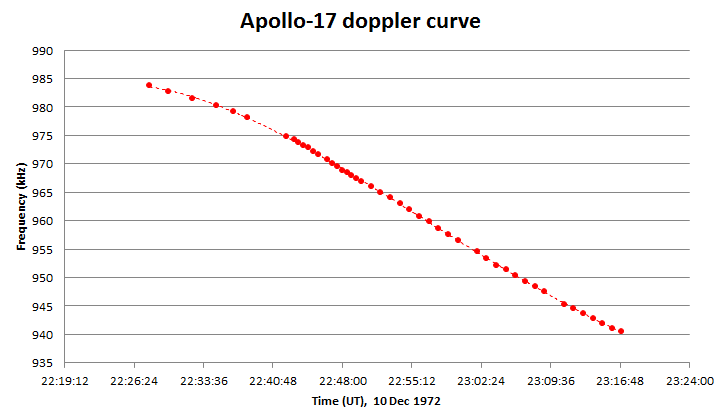
Each of the magazines containing photographs of empty Apollo S-
There are many, many Apollo 16mm, live TV and Hasselblad photos that contain verifiable views of Earth with mission hardware like the CSM and/or LM in shot. The S-
As with many of the claims made about the production of Apollo images, of whatever source, a moment’s thought introduces far more problems than the claims address. In short, it’s just not practical or possible. It’s a simpler exercise to send someone. The reason the voice communications seemed to be coming from the moon is because they were there. The many professionals and amateurs tracking it received signals from the moon because that’s where they were coming from. It’s also worth pointing out that the same youtuber claims that all the footage of Earth was done from geosynchronous orbit, which is completely at odds with the claim that it was done from the SIV-
Take, for example, some more claims by Mr Talboys (figure 5.9.11.20).

Figure 5.11.13: Jodrell Bank’s recording of Apollo 11’s descent to the lunar surface (left) and Parkes’ recording of the signal from Columbia (right). Below, ‘Moonwatch’ newsletter excerpts.



All you have to do is ready back what’s written above to know that while it used a Pulse Modulation system for tracking, just as the CSM did, S-
Another variation on the remote probe theme was posted on youtube, claiming that the images of Earth in the live TV broadcasts (at least from Apollo 8) were done using Lunar Orbiter images, over which a camera was panned to give the illusion of someone trying to keep a viewfinder-

Figure 5.11.18: Example frame showing how one person believes the TV view of Earth was captured.

Figure 5.11.9: Social media claims about the SIV-
This is despite the fact that the SIV-

Figure 5.11.10: Examples of SIV-
Those same impacts were recorded by Apollo seismometers, and mentioned during the missions, for example this reference from Apollo 13:
023:18:53 Kerwin … we have an S-
There are also many examples of images, video and TV of Earth taken after the SIV-
Another element to the ‘it could have been a remote probe’ notion is the story of Zond 5.
Zond 5 (which successfully took a biological payload to lunar orbit and back) famously sent transmissions of human voices back to Earth of cosmonauts reading out telemetry and preparing for a landing, allegedly provoking much alarm amongst the Americans and British listening in. The actual event varies depending on who’s telling the story. One version is that very much Earth bound cosmonauts were broadcasting to Zond 5 and the return signal was intercepted. Some cosmonauts have even claimed direct responsibility for the prank. A slightly more prosaic version of the tale (told here for example, and also in Brian Harvey’s ‘Soviet and Russian Lunar Exploration’) is that the transmissions were taped to test voice communications without the tricky business of sending a cosmonaut.
It’s also well known that radio hams like Larry Baysinger picked up Apollo 11 transmissions, and others picked up Apollo 15 voice communications. Readings from a number of other missions were also intercepted by amateur enthusiasts. Could these have been signals sent by an unmanned probe in lunar orbit?
Well, no. The Apollo 11 transmissions were missing the essential ‘Houston’ component -
The claim shown in figure 5.11.11 illustrates the confusion.
Figure 5.11.1b: Lunar Orbiter Earth image compared with NIMBUS mosaic and 3D reconstruction using digitally restored NIMBUS data
These images were well publicised at the time -
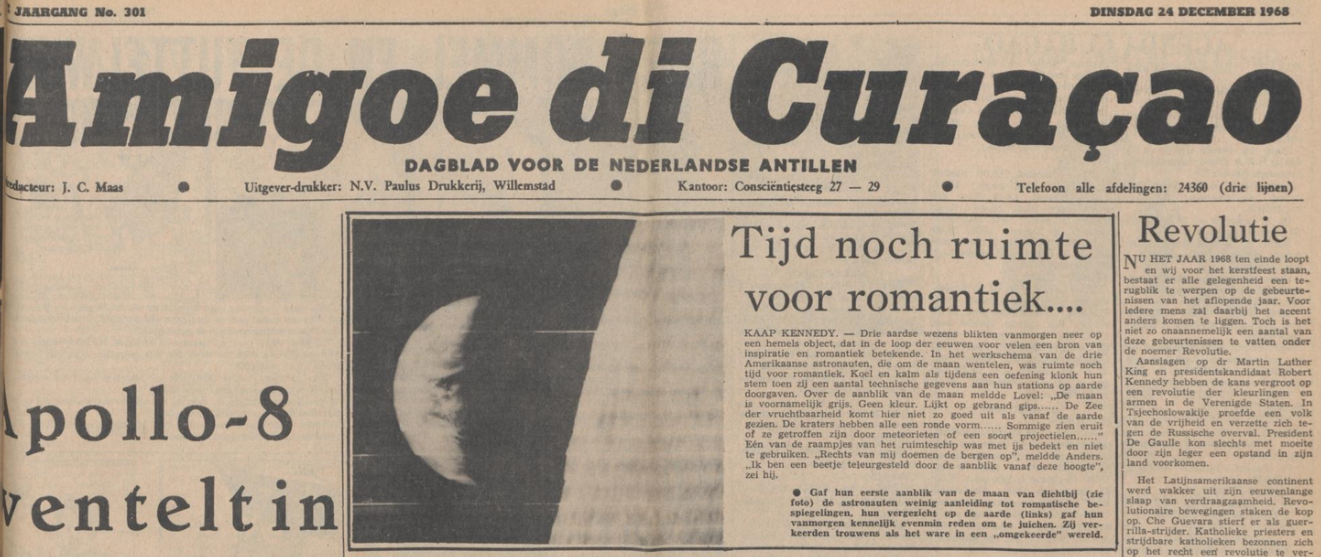
Rasa Viharii makes a new claim on this idea as part of a Q&A session where people could ask a panel of “experts” (and I really do use that term advisedly) anything on the missions. We’ll leave aside the fact that many people wanting to expose their dishonesty and lack of knowledge were blocked and ignored and focus on a snipped that Rasa was so proud of he made it into a separate video.
In it he reiterates his claims that the SIV-
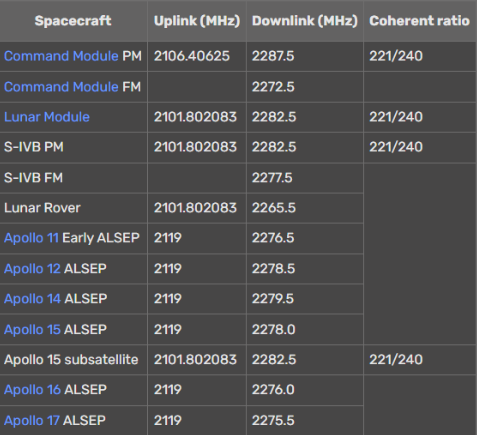
Figure 5.11.15: Apollo frequency assignments (source given in text)
He obviously doesn’t know why the ALSEPs might all have different frequencies, or that they continued transmitting for many years after the missions ended. He might like to read this 1975 PhD, which used a technique of intercepting ALSEP transmissions to locate them with a high degree of precision (and thus work out lunar libration more accurately).
It’s worth mentioning that the S-
“The S-
The S-
The LM & S-
While some insist that the S-
“The S-
And
"It should be noted that voice does not originate from the S-
I’m not going to make any claim to expertise in radio transmissions, but even without that expertise it’s not difficult to pick holes in Rasa’s little theory.
Firstly, we have live footage, photos and 16mm footage of the S-
If the footage and audio was all being rebroadcast from a CSM in LEO, what happens when the CSM is blocked by Earth from doing that transmission? Or when an S-
Ass already mentioned above, of the fact that the S-
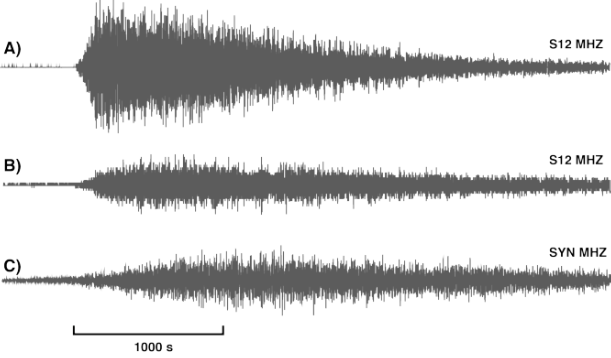
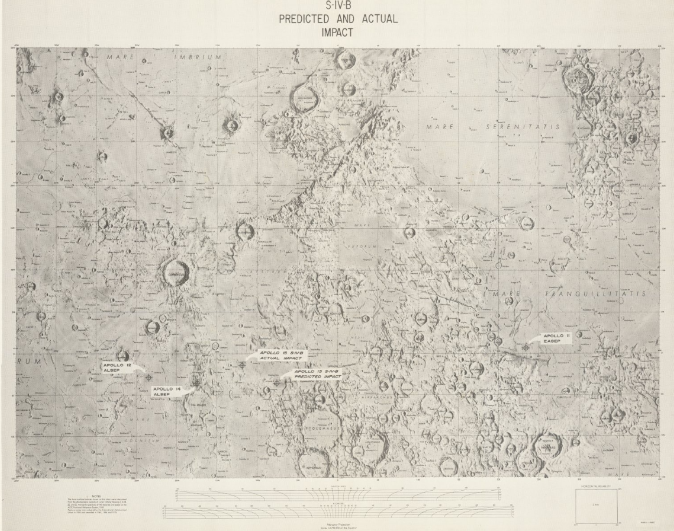
Figure 5.11.16: Apollo S-
Moonwatch observations also made into the Apollo 10 photography report (figure 5.11.14)
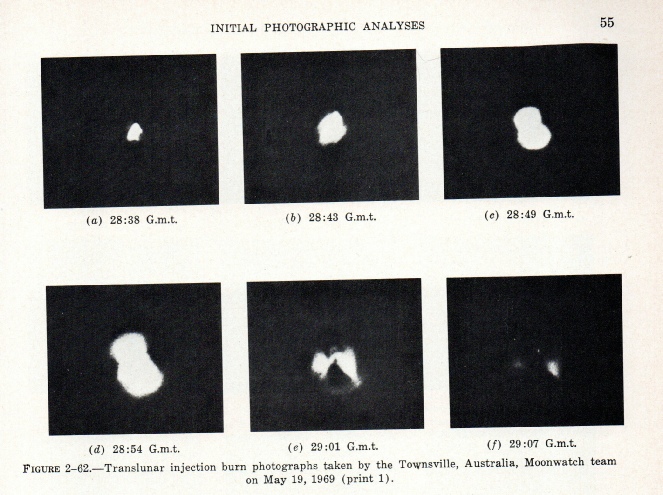
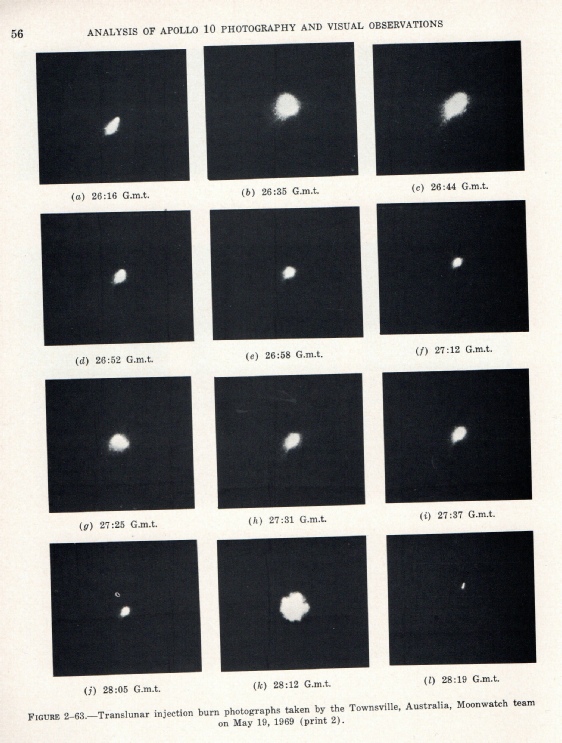
Figure 5.11.14: Operation Moonwatch observations of Apollo 10, included in the Apollo 10 photography report (my own copy)O.
Another problem for Rasa’s claim is where the same camera uses different lenses and films. As discussed in the Apollo 16 section, the always excellent Dave McKeegan debunks a claim about Apollo 16 photographs of Earth taken during TLC by showing that two different lenses were used in the same sequence of photographs.
On top of that, the same camera was used to take comparison photographs using UV and colour film magazines. Unless there was some massively complicated automation that allowed both the film magazine and lens to be switched, this can only have been done by people.
He expands on his theme in a later post (figure 5.11.9).
One contributor to the debate claims that amateur ham radio enthusiasts wouldn’t have had access to equipment in the necessary frequencies -
Rasa again doubles down saying that they would have needed Doppler radar to know where signals were originating, which again is not true -
A more recent contribution of his is shown in figure 5.11.17.
Figure 5.11.17: Social media hoax claims
There are a few issues with this claim.
First and foremost, by the time Apollo 8 happened there were no Lunar Orbiters in lunar orbit -
Secondly, as he rightly points out in his video, it took some time to get the photos from them. The images had to be taken, developed, transmitted and processed. The cameras also would need to be pointing in exactly the right place. The orbiters had to be redirected to get the view, and there was no guarantee that it would work as intended (see here). These two factors together mean that it would have been pretty much impossible to get a view of Earth consistent with the time of the live TV broadcast. Even if they used a satellite (such as ATS, footage from which is included in the video), the issue of collecting the image, processing it and producing a usable image over which a TV camera could be panned remains.
Finally, there’s the flaring that we see in the footage as the camera tries to adjust to an overly bright Earth -
The video also alleges that the camera pans too quickly in response to capcom’s “up a bit, down a bit” commands, but in reality there is no way to tell which of the instructions Apollo 8 is following -
The maker of that video, and Rasa, have claimed that the S-
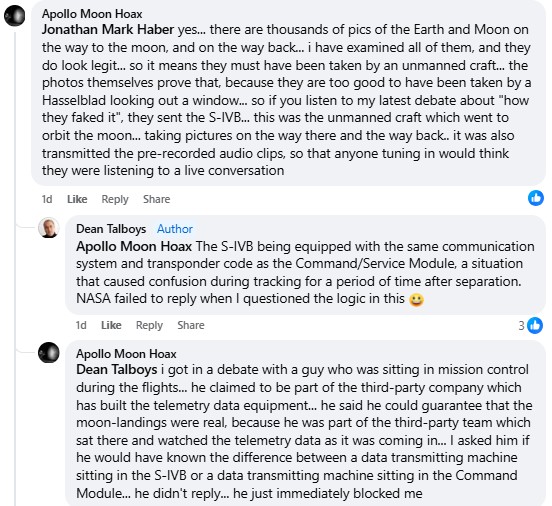


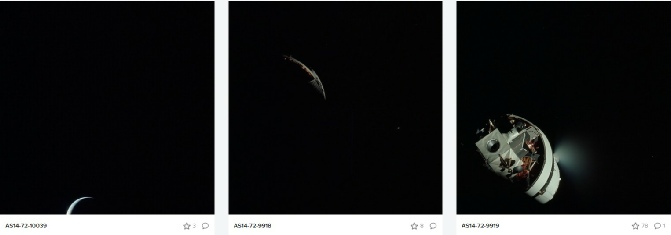

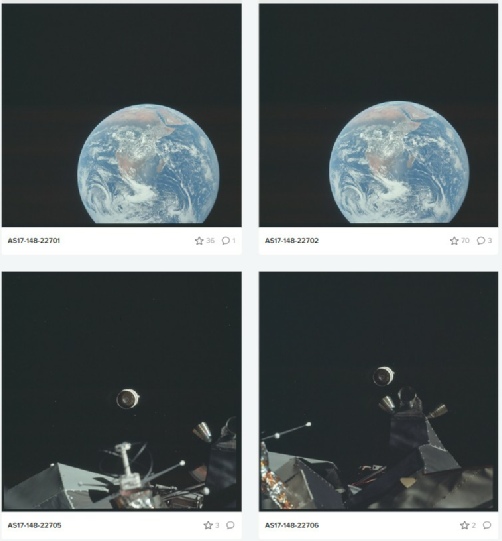
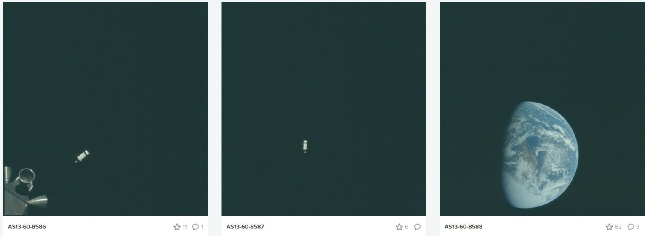
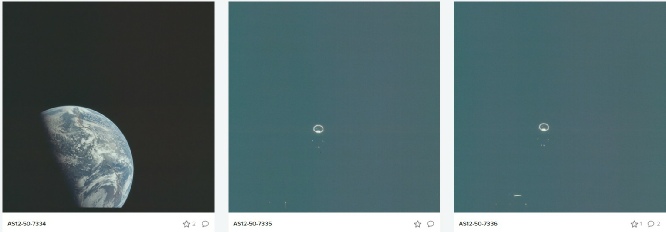
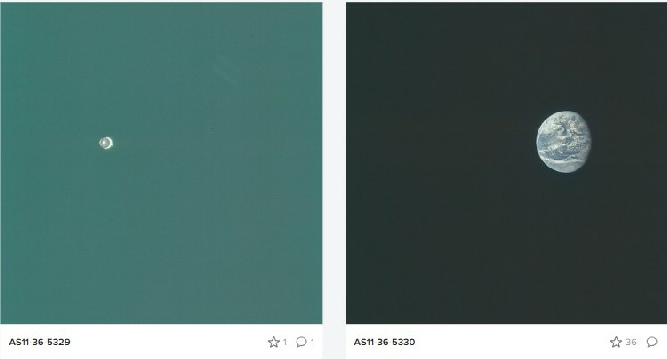
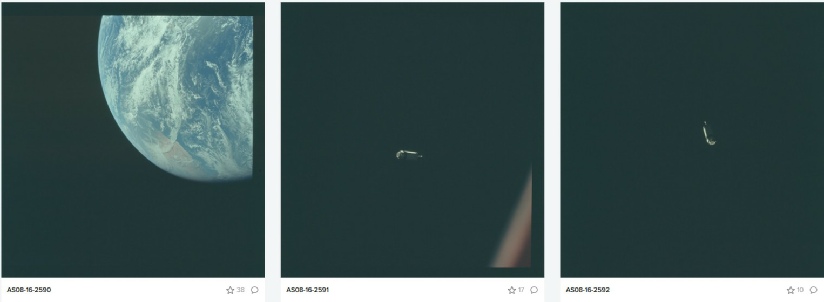
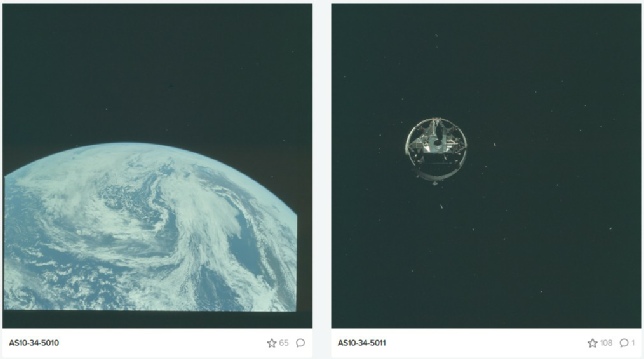
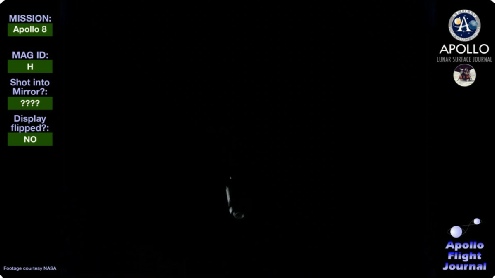
Figure 5.9.11.19: Photographs and video stills from Apollo missions, taken from the flickr archive, AFJ for Apollo 8, AFJ for Apollo 17
He’s using as an example an ‘Earthrise’ taken by lunar orbiter that’s already been discussed above. However, the claim that ‘NASA were using image enhancement’ is entirely unsubstantiated. How was this ‘enhancement’ being done? With what equipment? Where? By whom?
The part about Surveyor probes and their ‘hours of video’ is disingenuous. The Surveyor TV camera was not what anyone would recognise as one in TV broadcasting. It focused an image on a vidicon screen, which was scanned by an electron beam to convert brightness signals to a signal that could be transmitted to Earth. It was in no way a continuous live video feed, and could achieve one picture in just under 4 seconds. The exposure time could be varied to allow for focusing images in the lunar sky, as well as varying between near and distant objects. This document describes the probe in detail.
As for antennae, the probes had 3: a planar antenna (essentially a large square surface pointed at the sky) and two omni-
The ‘it was all done by a remote probe’ is a lazy, idle, glib throwaway dismissal based on nothing more than pre-
If you believe it was filmed by some remote vehicle, then you need to prove it. Find the vehicle concerned, tell the world how the images were transmitted back to Earth, who controlled the probe and from where, and more importantly tell the amateur wireless community why the work they did was wrong, what with them being the actual experts and not armchair window-
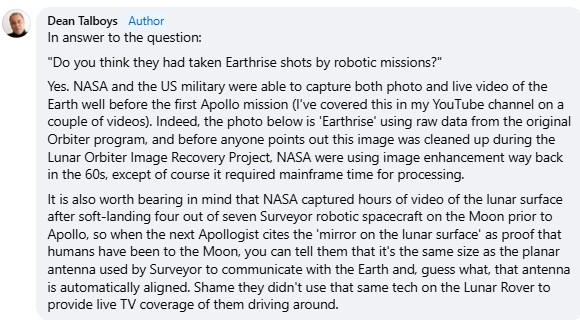
Figure 5.9.11.20: More social media tall stories.
